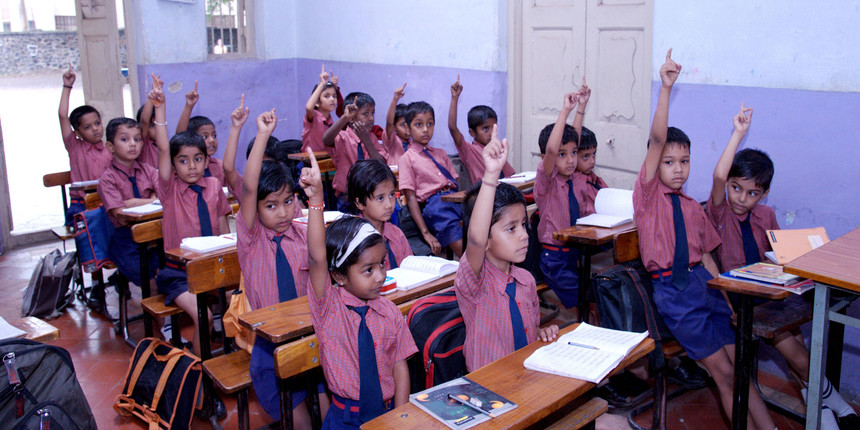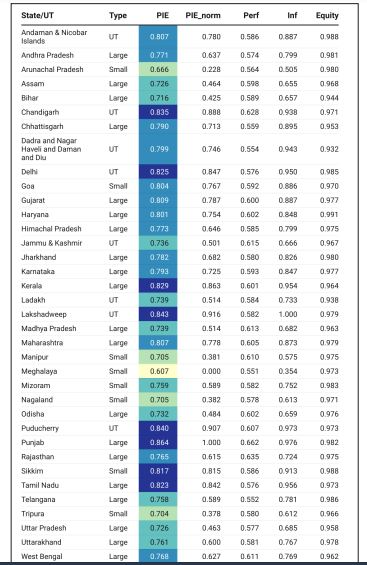Punjab schools best in performance, infrastructure, equity; small states need attention, says paper
Sanjay | July 18, 2022 | 12:21 PM IST | 5 mins read
Punjab, Rajasthan judged best states in school education performance, infrastructure, equity index devised by Observer Research Foundation (ORF).

NEW DELHI: Punjab is the best performing state, while Meghalaya is ranked the lowest in Performance, Infrastructure and Equity (PIE) Index 2020-21. The index has been developed to measure the health of the Indian primary and secondary education system broadly on three parameters – performance, infrastructure and equity. The index was published on Friday in a paper released by the think-tank, Observer Research Foundation (ORF).
The PIE index has divided the states and union territories (UTs) into three categories: large states, small states, and union territories. According to the paper titled ‘The PIE Index 2020-2: Measuring the health of primary and secondary education systems in India’, UTs performed the best and small states were ranked lowest. The education ministry has its own tool – the Performance Grading Index (PGI) – and on the latest one assessing education district-wise, three districts in Rajasthan were in the top category.
Also Read | No retest, CUET 2022 candidates can write at any centre if they reach on time: UGC Chairman
In the PIE index, Punjab emerged as the best-ranking large state and it is closely followed by Kerala and Tamil Nadu in that group, while the worst-performing were Uttar Pradesh and Bihar. Among the small states, Sikkim and Goa were top-ranked, while Meghalaya and Arunachal Pradesh were the lowest. Among UTs, Lakshadweep, Puducherry and Chandigarh performed exceedingly well.
The PIE index has been used to track changes in education from 2016-17 to 2020-21. Learning outcomes, infrastructure, and equity must all be given attention, the paper says.
“States and UTs should strive towards bridging the gap between private and government schools, boys’ and girls’ education, and caste-based differences in grades. Affirmative action is needed to make certain that girl students and other marginalised groups are not left behind,” paper states.
The paper asserts that National Education Policy (NEP), 2020, is expected to usher in substantial improvements in education and “could favourably impact learning outcomes across the nation”.
“The NEP also seeks to increase access and equity through online courses, which would have a positive effect on equity,” it says.
Also Read | Tulsi-worship, rote-learning, Hanuman’s food habits: What Karnataka’s NEP 2020 position papers say
School Education: NAS, U-DISE
PIE Index for India’s states and UTs is developed from the perspectives of both outcomes and processes. However, it does not factor in governance processes aiding outcomes such as attendance, teacher availability, and transparency.
The PIE index uses data from the National Achievement Survey (NAS 2021) for performance and equity sub-indices, and data from Unified District Information System for Education (UDISE 2020-21) for measuring the infrastructure sub-index.
The scores in English and maths were used to evaluate the performance of the school system. The differences in learning outcomes of students from marginalised communities – based on gender, caste, school type – in Classes 3, 5 and 8 were considered to measure equity. Availability of separate toilets for males and females, drinking water, classrooms with electricity and working computers were factors considered for the infrastructure sub-index with data from U-DISE.
Also Read | NIRF University Ranking 2022: IISC Bengaluru retains top position
“Education was a common topic of interest for all of us and with increasing importance being given to it in India (through NEP etc.), we thought it would be interesting to examine the health of education systems across states. This index would also provide insight to state level policymakers in terms of how they can improve their systems which could be helpful during the implementation of NEP in a data-driven manner. The main aim of the paper is to help optimise educational outcomes in terms of performance, infrastructure, and equity for each state and UT,” Tanmay Devi, PhD student in economics at Rice University, US told Careers360.
Devi is one of the paper’s three authors; the others are Vanshika Surana, applied mathematics graduate from FLAME University, Pune and Rhea Shah, master’s student in business analytics at Duke University, US.
East, northeast lag
The final PIE Index shows that Punjab and Rajasthan are performing the best, while Telangana and Meghalaya were at the bottom. Lakshadweep and Punjab ranked highest in the infrastructure sub-index, while Arunachal Pradesh and Meghalaya were lowest. On the equity sub-index, Haryana and Sikkim are at the top, while Ladakh, Dadra and Nagar Haveli and Daman and Diu are lowest.
Overall, large states perform significantly better than the small states. However, UTs have out-performed both; Lakshadweep, Puducherry and Chandigarh are all very close to one another on the index.
 PIE index of states and UTs (picture source: ORF)
PIE index of states and UTs (picture source: ORF)
In large states, Punjab emerged as the leading state for primary and secondary education across all three three sub-indices. “The emergence of Punjab as the best-performing state in the PIE index 2020-21, could be explained by its active implementation of education reforms. Other states can learn from its experience,” it says. The state restructured its education system by implementing a ‘smart school’ policy, online teacher transfers policy, online education, and distribution of free smartphones.
Punjab is closely followed by Kerala, the state with the highest literacy level of 93.91 percent (as per the 2011 census). Though Kerala has the highest literacy level, the state has relatively lower value in performance (0.601) and equity (0.964) compared to Punjab.
Also Read | Kerala: Women in chemical sciences face caste, gender bias, finds study
Eastern and north-eastern states have a poor PIE Index value. Although they are doing well on the performance index, they lag in infrastructure. Small states have the lowest score on this parameter. Lakshadweep ranks first on infrastructure among all states and UTs due to its relatively small number of schools around 45.
“In most states, around 90 percent of all schools had separate toilets for males and females, drinking water, and functional classrooms. However, only about 85 percent had access to electricity and 50 percent had working computers. Indeed, in some states such as Tripura, only 20 percent of schools had access to electricity, and in Bihar and Meghalaya, the proportion of those with working computers is 15 percent,” the paper noted.
Follow us for the latest education news on colleges and universities, admission, courses, exams, research, education policies, study abroad and more..
To get in touch, write to us at news@careers360.com.
Next Story
]NEET 2022 Live: NEET UG answer key pdf available, cut off, solved papers, result date, college predictor
NEET 2022 Live: Check the latest updates on NEET 2022 answer key PDF, paper analysis, question papers, difficulty level, expected cut off for MBBS, BDS and other courses, college predictor, result date and more.
Sonia Vats